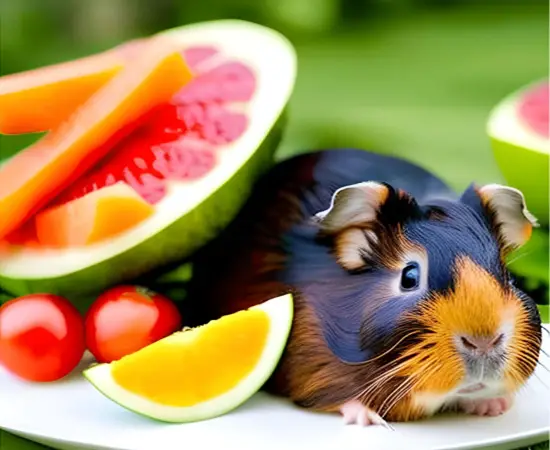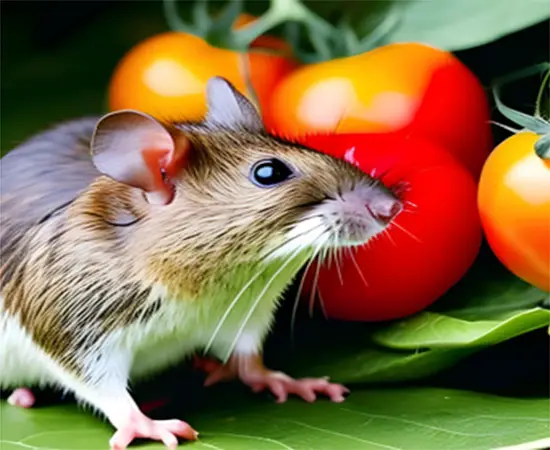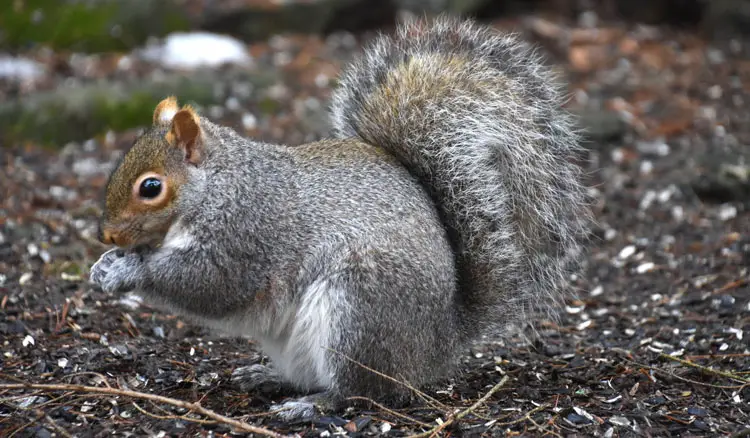Hey there, fellow guinea pig enthusiasts! If you’re sharing your life with these adorable, squeaky companions, you’re already aware of the joy they bring to your days. But did you know that one of the most crucial ways you can show your guinea pigs you care is by providing them with the proper nutrition? That’s right – just like us, guinea pigs need a balanced and healthy diet to thrive. In this article, we’re diving deep into the world of guinea pig nutrition, exploring everything from their dietary needs to what foods are safe and what to avoid. So buckle up, and let’s explore the wonderful world of “What Can Guinea Pigs Eat.”

What Can Guinea Pigs Eat?
Guinea pigs are the true foodies of the animal kingdom! Their menu is more diverse than you might think. From vibrant veggies to juicy fruits, these little pals have a taste for the good stuff. The key? Freshness and safety. Think of their diet as a colorful palette, with each food group adding its unique flavor. Whether it’s leafy greens or crunchy treats, offering a variety of foods keeps their taste buds dancing and their health in tip-top shape. Remember, just like we enjoy a well-prepared meal, guinea pigs relish a balanced diet full of fresh and safe options. So, let’s dive into the smorgasbord of foods that can make your guinea pigs’ mealtime a delightful and nutritious experience!
Key Nutritional Needs
Guinea pigs might be small, but their nutritional needs are anything but. Just like us, they rely on a balance of essential nutrients to thrive. Picture a jigsaw puzzle, with each piece representing a different nutrient that comes together to form their overall health. These little pals require a mix of fiber, protein, vitamins, and minerals for their daily dose of goodness.
Nutritional Requirements:
- Fiber: Fiber is the backbone of a guinea pig’s diet. It keeps their digestive system in tip-top shape, preventing issues like bloating and constipation. Think of it as nature’s broom, sweeping away any tummy troubles.
- Protein: Protein is the muscle builder. It’s important for growth, maintaining healthy skin and fur, and overall body repair. While guinea pigs aren’t bodybuilders, a good protein intake keeps them strong and resilient.
- Vitamins: Just like how we gobble down our vitamins, guinea pigs need theirs too. Vitamin C is a superstar here – it’s essential for their immune system, as well as promoting healthy teeth and bones.
- Minerals: These tiny treasures play a big role in guinea pig health. Calcium keeps their bones strong, while phosphorus helps with energy metabolism. And don’t forget potassium, which keeps their heart ticking nicely.
Best Foods for Guinea Pigs
Now you might be wondering, “What’s the perfect guinea pig meal?” Let’s explore
Ideal Diet Mix
For guinea pigs, the perfect diet is a blend of veggies, fruits, and specialized commercial food. These elements come together to create a wholesome culinary experience that promotes their overall well-being.
Food Variety
Guinea pigs relish a diverse menu. Fresh veggies like crisp lettuce and crunchy carrots, along with juicy fruits such as berries and melons, add a burst of flavor. Complementing these are specially formulated pellets, a nutritional powerhouse that completes their diet with essential elements.
Importance of Diversity
Just as we enjoy a range of foods, guinea pigs thrive on variety. Diverse meals not only keep them excited but also supply a spectrum of vital nutrients. By rotating their menu, you ensure their contentment and health flourish.
Exploring Specific Foods
Alright, let’s play the ultimate game of “Can They Eat It?” Think of this section as your guinea pig’s food detective agency – we’re here to uncover the truth about what’s safe and what’s not in their dining adventure.
Animal Proteins: While these proteins are not a strict no-no, they’re like the occasional treats you indulge in. A nibble of cooked, lean meat or boiled egg is okay, but remember, moderation is key. Too much protein can throw off their delicate nutritional balance.
Avocados: Now, let’s talk about the mysterious case of the avocado. It might be a green wonder for us, but for guinea pigs, it’s a culinary villain. Avocado contains a substance called persin, which is toxic for them. So, when it comes to avocados, keep them far, far away from your little detectives.
Rabbit Food: Here’s the scoop on rabbit food – it’s not the star of your guinea pig’s menu. While it won’t harm them if they nibble on a bit, it shouldn’t be their main course. Guinea pigs need a more diverse diet to thrive, so keep rabbit food as an occasional cameo in their foodie adventures.
Rhubarb, Chives, Garlic, Leeks, Onions: Time to solve the case of the “Allium Gang.” These members, including chives, garlic, leeks, and onions, are known to cause stomach upset and even potential anemia in guinea pigs. The mystery here is that these seemingly innocent ingredients can be quite harmful – better to avoid them altogether.
Fruit Seeds or Fruit Pits: Imagine your guinea pig as a seed-spitting champion – quite the spectacle, right? But hold on, this is no contest. Fruit seeds and pits can be a choking hazard and might contain traces of cyanide. Keep these potential hazards out of their meals to ensure safe munching.
Lamb’s Lettuce, Beet Greens, Peanut Butter, Sunflower Seeds, Squash: It’s time for some good news – the “Yum List.” Lamb’s lettuce, beet greens, peanut butter (in tiny amounts), sunflower seeds, and squash are all on the guinea pig-friendly list. These treats can add a bit of excitement to their meals, but remember, portion control is still key.
Hot Peppers: The hot peppers are bringing the heat to our investigation. In this case, however, the heat is not what we’re after. Hot peppers, just like chili for us, can cause tummy troubles for your guinea pigs. Avoid giving them anything spicy – their taste buds prefer the milder side of life.
House Plants: Here’s a mystery to solve: are house plants safe for guinea pigs? The truth is, some plants are perfectly harmless, while others can spell disaster. It’s a good idea to research the plants in your home and make sure they’re not on the “toxic” list for your furry friends.
Tomatoes: Ah, the enigma of tomatoes. While they seem innocent enough, tomato leaves and stems contain a substance called solanine that can be harmful to guinea pigs. Stick to offering them ripe tomato slices in moderation, sans the leaves and stems.
Raw Potatoes: Now, here’s a case that’s easy to crack – no raw potatoes for your guinea pigs. Raw spuds contain a toxin called solanine, which can lead to tummy troubles and other health issues. Stick to the cooked and cooled versions if you’re going to share the potato love.
Chocolate: Let’s solve the “chocolate caper.” As much as we adore this treat, it’s a definite no-go for guinea pigs. Chocolate contains substances that can be toxic to them. Keep your sweet treats out of their sight and reach to avoid any cocoa-related mysteries.
Each of these foods presents its own unique puzzle to solve – figuring out what’s safe and what’s off-limits for your guinea pig companions. As their culinary guardian, it’s your job to ensure they’re only munching on the best and most nutritious bites. Remember, being a guinea pig’s chef comes with great responsibility!
The Role of Hay and Grass
Hay and grass are like the unsung heroes in the guinea pig world, quietly playing a vital role in their health and happiness. These fibrous delights might seem simple, but they’re crucial for your furry pals.
Importance of Hay and Grass
Imagine if guinea pigs were architects, hay and grass would be the foundation of their diet. These fibrous wonders aid digestion, prevent dental problems and keep their little tummies moving smoothly. They’re like nature’s broom, sweeping away potential digestive hiccups.
Benefits of High-Quality Hay and Fresh Grass
Now, let’s talk quality. Just like we prefer fresh produce, guinea pigs have a penchant for the good stuff too. High-quality hay is rich in nutrients and fiber, giving them the energy they need to do all those adorable popcorning moves. Fresh grass? It’s like a gourmet salad that’s not only yummy but packed with vitamins too.
Suitable Types of Hay and Grass
Guinea pigs aren’t picky eaters, but they do have their preferences. Timothy hay is like the superstar – it’s the go-to choice for most guinea pigs. Orchard grass and meadow hay are equally delightful options. When it comes to grass, a bit of backyard foraging (make sure it’s safe!) or some store-bought grass can add variety to their diet.
Vegetables and Fruits
Guinea pig nutrition gets a vibrant boost from vegetables and fruits. These goodies aren’t just tasty treats; they’re essential for their well-being. Safe choices include leafy greens, bell peppers, carrots, and low-sugar fruits like strawberries and blueberries.
Variety is Key
Just like we enjoy different foods, guinea pigs thrive on diversity. Rotate veggies and fruits for a well-rounded nutrient intake – it’s like a mini buffet for them!
Moderation Matters
While these treats are fantastic, remember the golden rule: moderation. Some fruits pack natural sugars, so a little nibble here and there keeps their diet balanced and their tummies happy.
Remember, moderation is vital, as too much of a good thing can sometimes be… well, not so good.
Commercial Food and Pellets
Ever heard the saying, “You are what you eat”? Well, that holds true for our guinea pig buddies too. When it comes to their nutrition, commercial food and pellets play a significant role.
Role in Guinea Pig Nutrition
Think of commercial food and pellets as the backbone of your guinea pig’s diet. These specially formulated goodies are designed to provide a balanced mix of nutrients that your furry pals need to thrive. They’re like little nutritional powerhouses that ensure your guinea pigs are getting all the essentials in one convenient package.
Choosing Quality Options
Now, not all commercial food is created equal. When shopping for these miniature meals, opt for high-quality options from reputable brands. Look for those that are specifically tailored for guinea pigs. These formulas are crafted with their dietary needs in mind, ensuring they get the right mix of fiber, vitamins, and minerals. It’s like giving them a gourmet meal every day!
Reading Ingredient Labels
Ah, the fine print – it matters! Just like you wouldn’t buy a product without reading the label, don’t scoop up guinea pig food blindly. Flip that package over and read the ingredient list. Avoid foods that contain excessive fillers, artificial additives, or loads of sugar. Instead, go for options where the first few ingredients are recognizable – like timothy hay, alfalfa, and veggies.
Always read those ingredient labels – your guinea pigs deserve the good stuff.
Treats, Supplements, and Hydration
Treats and Supplements: Think of treats as a little dash of joy in your guinea pig’s day. They’re like the cherry on top, adding excitement to their meals. However, remember that treats should be occasional, not a daily affair. Too many treats can lead to an imbalanced diet, so keep them in check. When it comes to supplements, multivitamins and mineral wheels can be like insurance for their health. These tiny extras ensure your furry pals are getting all the nutrients they need, but don’t let them steal the spotlight from fresh, natural foods.
Fresh Water: Imagine wandering through a desert – that’s how important water is to guinea pigs. These small creatures need a constant supply of fresh, clean water. It’s not just for drinking; they also use it to clean themselves and stay cool. Make sure their water bottle is always full so that your guinea pigs start drinking water when they need it, and give it a good rinse regularly. Hydration is the key to a healthy, happy guinea pig.
Foods to Avoid
Think of this section as your guinea pig’s “no-go” list. Some foods are off-limits like that “do not enter” sign on a closed road.
Here’s a concise breakdown table of the foods to avoid for guinea pigs:
| Food | Reason for Avoidance |
|---|---|
| Chocolate | Contains theobromine, harmful to guinea pigs. |
| Onions, Garlic, Chives | Can damage red blood cells and lead to anemia. |
| Avocado | Contains persin, toxic to guinea pigs. |
| Citrus Fruits | High acidity can cause digestive issues. |
| Iceberg Lettuce | Lacks nutritional value; opt for better greens. |
| Raw or Green Potatoes | Raw potatoes upset stomachs; green ones contain solanine. |
| Rhubarb | Oxalic acid in rhubarb can harm sensitive digestive systems. |
| Seeds and Pits | Choking hazards and potential harmful chemicals. |
| High-Fat, High-Sugar | Difficult for guinea pigs to process; health consequences. |
| Dairy Products | Lactose intolerance leads to stomach discomfort. |
| Processed and Junk | No nutritional value; may cause health problems. |
| Beans | Complex sugars cause gas and bloating. |
Each of these foods poses a risk to your guinea pig’s well-being, whether due to toxic compounds, indigestibility, or potential health issues. Sticking to a safe and approved diet ensures the health and happiness of your furry companions.
Crafting a Balanced Diet
Planning a guinea pig’s diet? It’s like piecing together a delicious puzzle. Here’s the lowdown:
Key Points to Consider
- Balance is Bliss: Imagine a seesaw – hay, veggies, pellets, and fruits are the players. Balancing these keeps your guinea pig’s tummy and health in check.
- Variety, Variety, Variety: Think of your guinea pigs as food explorers. Different foods offer different nutrients. Mix it up to keep their interest piqued.
- Portion Patrol: Just like us, guinea pigs have their limits. Don’t overload their plate. Moderation is your BFF.
Practical Tips
- The Hay Hook-Up: Always have hay on hand. It’s their main squeeze. Go for fresh, high-quality hay – it’s like a gourmet meal for them.
- Veggie Voyage: Introduce new veggies slowly. Watch for any tummy rumbles or reluctance. Not all veggies are created equal – some are best in small doses.
- Pellet Power: Pellets are like the side dish in this meal. High-quality ones are the gold standard. A small scoop a day keeps them content.
- Fruit Finesse: Fruits are nature’s candy – a sweet treat! But remember, a little goes a long way. A bite-sized portion is all they need.
- Trial and Tailwags: Every guinea pig is different. Test their taste buds with new foods, but keep an eye out for any reactions. Safety first!
- Water Works: Hydration is non-negotiable. Fresh water is their lifeline. Make sure it’s available 24/7.
- Rotate and Rejoice: Rotate the menu – it’s like taking them on a culinary adventure. Plus, it prevents pickiness and adds excitement.
Crafting a balanced diet is like painting a masterpiece. Each brushstroke matters. So, think balance, variety, and a dash of portion control. Your guinea pig’s taste buds will thank you!
Frequently Asked Questions
Can guinea pigs eat meat or animal proteins?
Yes, guinea pigs can consume a small amount of animal proteins like cooked, lean meats. However, it’s essential to keep these portions minimal and infrequent. Their digestive systems are designed for plant-based foods, so animal proteins should never become a primary part of their diet.
Why is hay so crucial for guinea pigs?
A: Hay is a guinea pig’s dietary lifeline. It’s not just a snack – it’s essential for healthy digestion and dental care. The rough texture of hay wears down their teeth as they chew, preventing overgrowth. Plus, it keeps their gut moving smoothly, preventing potential blockages.
Can guinea pigs eat commercial food alone?
A: While commercial food and pellets have their place, they shouldn’t be the sole source of nutrition. These foods are formulated to provide a basic balance of nutrients, but guinea pigs thrive on a variety of fresh foods. Think of pellets as a supporting actor in the grand culinary performance that is your guinea pig’s diet.
Conclusion
There you have it – a feast of knowledge about what guinea pigs can and can’t eat. By now, you’re practically a guinea pig nutrition guru! Remember, a happy guinea pig is a well-fed one, so take this information and apply it to your furballs’ diets. Here’s to many years of squeaks, snuggles, and healthy guinea pigs. Happy feeding!






